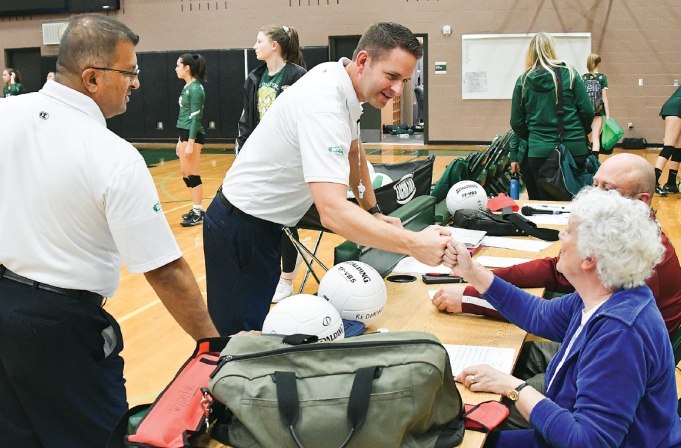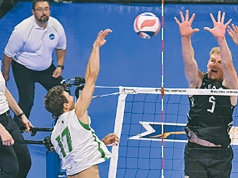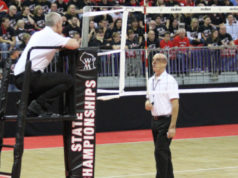Each level of volleyball has its own time management challenges. This article will focus more toward junior club and high school matches where you will often have youth players serving as part of your officiating team and/or working at the scorer’s table. As the first referee (R1), faster arm signals won’t make the game move quicker, but what will keep the game moving is your time and court management. I like to divide the time and court management into three phases: (1) setting up the match, (2) the match itself, and (3) after the match.
Setting Up the Match
During the captains’ meeting — besides the regular protocol — emphasize to the captains that all shanked balls must be retrieved prior to their team huddles between rallies. Be adamant that they inform their teammates to retrieve shanked balls.
Be spot on with your time for warmups. If you must use the restroom, make sure the working crew’s coach (USAV), not player, is keeping the time.
Ask your line judges to keep an eye out for any volleyballs coming from another court. Let them know they play an integral part in keeping the game moving.
Demonstrate and explain to the second referee (R2), the scorekeeper and the libero tracker their match duties. Explain the substitution process; that the R2 will blow the whistle twice and then she or he will tell the scorekeeper the number of the player substituting in for the current player on the court and for which team. Emphasize the positives of working as a team and that the flow of the game will move smoother with their assistance.
Inform the scoreboard operator and scorekeeper to wait and follow your signal for points before they change the score. This is important because sometimes the person operating the electronic or manual scoreboard will react as soon as the play ends and award a point to the wrong team.
Most importantly, stress no cell phones can be used at the table while the match is in play. This can seriously disrupt the flow of the match and is a near certainty that a mistake will occur.
The Match
As the R1, within the first five to six points of the match, you need to establish the pace of the game. As soon as the server has the ball and looks toward the court, beckon for serve. Prior to the server receiving the ball, you should have enough time to check the scoreboard, check with your R2, see if there are any substitutions or timeouts, scan the court and be ready to whistle and beckon for serve. Once you set the pace, the players will adjust with their substitution rotations and serving patterns.
Another situation you might have is the coach will call a timeout and your R2, with a weak whistle, might indicate a timeout, and you already beckoned for serve. Use your judgment on this one. Call over the R2 to confirm she or he did call a timeout. This does happen often because the coaches, trying to strategize, will wait until the last moment to request a timeout. Anticipate such a scenario to avoid any conflicts.
When it’s a tight game or a team is getting defeated badly early in the game, anticipate timeout requests. If the game is in the 20s for both teams, you should expect timeouts coming from both coaches.
Periodically, during a timeout, call your line judges and R2 over and let them know they are doing a good job of keeping the game moving. Such support goes a long way. However, if the line judges are not paying attention, emphasize their responsibility and the next time they make the correct signal, give them a thumbs up. These types of interactions can keep your court moving.
Keep your timer for timeouts and between sets right on. If you must blow your whistle a couple of times to get the teams back on the court, do so. Also, if you notice a coach is consistently exceeding the time allowed during timeouts, call the captain over and explain this is a courtesy warning and, if it continues, a sanction will be assessed. The coach might give you the thumbs up acknowledging your message. Try to reply with thumbs up in return. This way there is an understanding and the game keeps moving.
Many officials like to write the substitutions on their lineup card for every sub at the high school level. This can eat up valuable time. If the personnel at the table have a good grasp of what is taking place, this is not necessary. Trust your table workers and you will save valuable seconds during the match. As the R1, if you notice the process is not working, take an official’s timeout and remind the work crew of the process.
After the Match
Once the match has concluded, check the scoresheet for accuracy. Some coaches and players may thank you, but keep it brief so that you can move on to the next match.
Be sure to locate the game ball, have closure with the match you just finished and whistle for captains to start your next match.
You will always encounter some match delays that cannot be prevented such as injuries, equipment/court malfunctions, protests, etc. But do what you can to control what you can. So remember, check the scoreboard, check with your R2, check for substitutions, scan the court, locate the ball, recognize the server, beckon for serve and keep the game moving.
Roman Marushka, Glenview, Ill., is a USAV regional referee and an IHSA certified referee. He still plays competitive men’s volleyball in USAV sponsored tournaments around the country
What's Your Call? Leave a Comment:
Note: This article is archival in nature. Rules, interpretations, mechanics, philosophies and other information may or may not be correct for the current year.
This article is the copyright of ©Referee Enterprises, Inc., and may not be republished in whole or in part online, in print or in any capacity without expressed written permission from Referee. The article is made available for educational use by individuals.



















